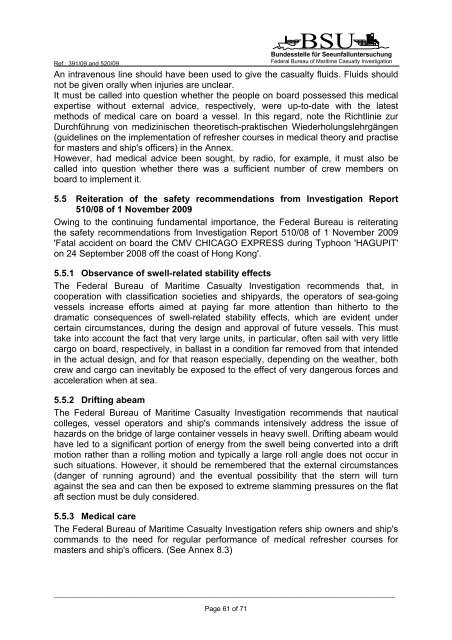SUB-COMMITTEE ON STABILITY AND LOAD LINES AND ON ...
SUB-COMMITTEE ON STABILITY AND LOAD LINES AND ON ...
SUB-COMMITTEE ON STABILITY AND LOAD LINES AND ON ...
You also want an ePaper? Increase the reach of your titles
YUMPU automatically turns print PDFs into web optimized ePapers that Google loves.
Ref.: 391/09 and 520/09<br />
BSU<br />
Bundesstelle für Seeunfalluntersuchung<br />
Federal Bureau of Maritime Casualty Investigation<br />
An intravenous line should have been used to give the casualty fluids. Fluids should<br />
not be given orally when injuries are unclear.<br />
It must be called into question whether the people on board possessed this medical<br />
expertise without external advice, respectively, were up-to-date with the latest<br />
methods of medical care on board a vessel. In this regard, note the Richtlinie zur<br />
Durchführung von medizinischen theoretisch-praktischen Wiederholungslehrgängen<br />
(guidelines on the implementation of refresher courses in medical theory and practise<br />
for masters and ship's officers) in the Annex.<br />
However, had medical advice been sought, by radio, for example, it must also be<br />
called into question whether there was a sufficient number of crew members on<br />
board to implement it.<br />
5.5 Reiteration of the safety recommendations from Investigation Report<br />
510/08 of 1 November 2009<br />
Owing to the continuing fundamental importance, the Federal Bureau is reiterating<br />
the safety recommendations from Investigation Report 510/08 of 1 November 2009<br />
'Fatal accident on board the CMV CHICAGO EXPRESS during Typhoon 'HAGUPIT'<br />
on 24 September 2008 off the coast of Hong Kong'.<br />
5.5.1 Observance of swell-related stability effects<br />
The Federal Bureau of Maritime Casualty Investigation recommends that, in<br />
cooperation with classification societies and shipyards, the operators of sea-going<br />
vessels increase efforts aimed at paying far more attention than hitherto to the<br />
dramatic consequences of swell-related stability effects, which are evident under<br />
certain circumstances, during the design and approval of future vessels. This must<br />
take into account the fact that very large units, in particular, often sail with very little<br />
cargo on board, respectively, in ballast in a condition far removed from that intended<br />
in the actual design, and for that reason especially, depending on the weather, both<br />
crew and cargo can inevitably be exposed to the effect of very dangerous forces and<br />
acceleration when at sea.<br />
5.5.2 Drifting abeam<br />
The Federal Bureau of Maritime Casualty Investigation recommends that nautical<br />
colleges, vessel operators and ship's commands intensively address the issue of<br />
hazards on the bridge of large container vessels in heavy swell. Drifting abeam would<br />
have led to a significant portion of energy from the swell being converted into a drift<br />
motion rather than a rolling motion and typically a large roll angle does not occur in<br />
such situations. However, it should be remembered that the external circumstances<br />
(danger of running aground) and the eventual possibility that the stern will turn<br />
against the sea and can then be exposed to extreme slamming pressures on the flat<br />
aft section must be duly considered.<br />
5.5.3 Medical care<br />
The Federal Bureau of Maritime Casualty Investigation refers ship owners and ship's<br />
commands to the need for regular performance of medical refresher courses for<br />
masters and ship's officers. (See Annex 8.3)<br />
_____________________________________________________________________________________________________<br />
Page 61 of 71
















